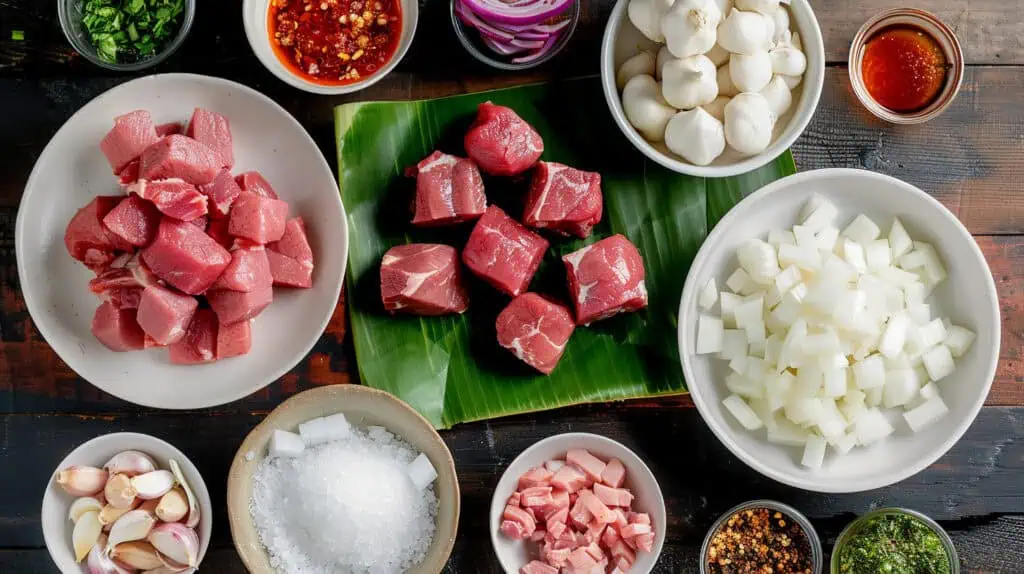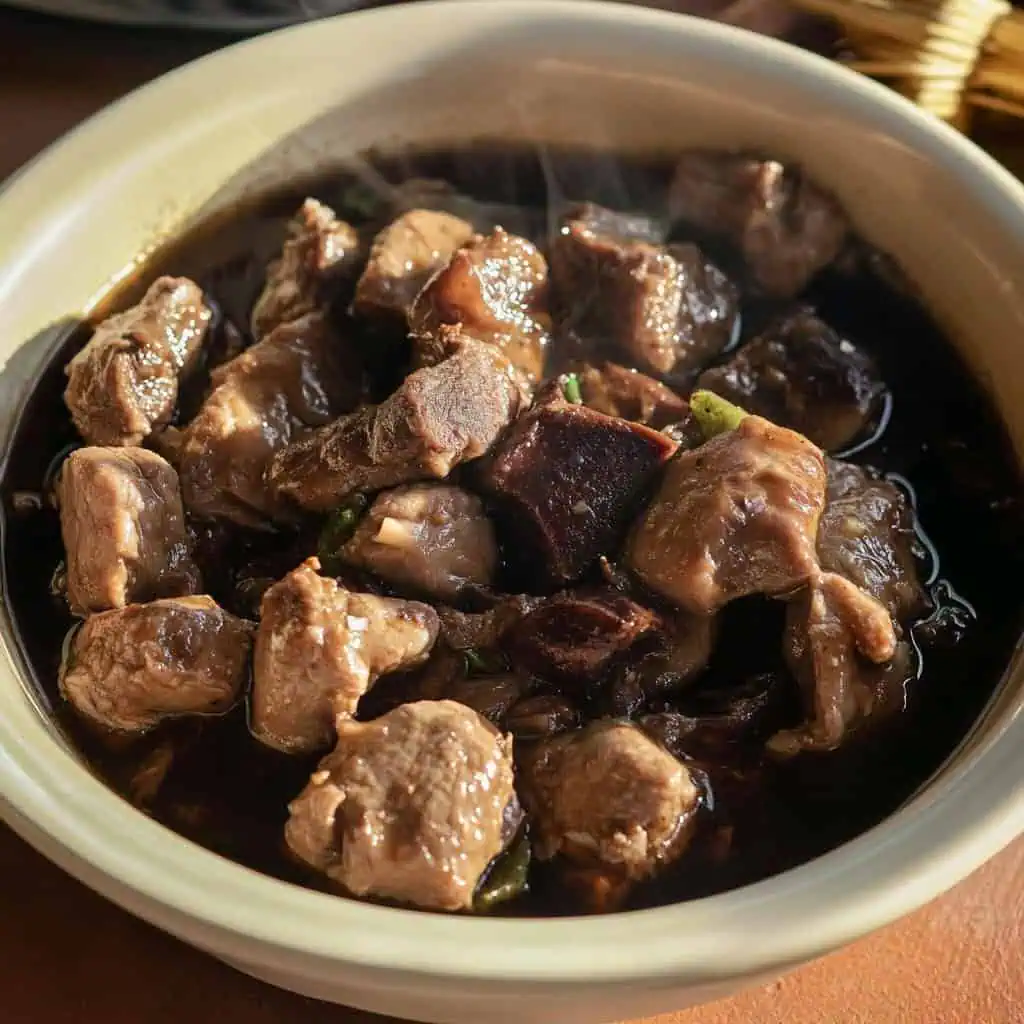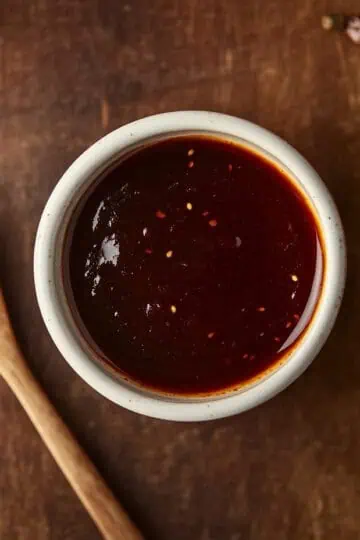This treasured family recipe, passed down through generations of Kapampangan cooks, holds a special place in my heart not just for its bold, tangy flavors, but for how it reminds me of those precious moments watching my grandmother transform humble cuts of meat into something extraordinary.
The secret, she would always tell me while stirring her trusted palayok, lies in the perfect balance of native vinegar and patient cooking that allows the pork and liver to become incredibly tender.
I'm excited to share our family's authentic Kapampangan Kilayin recipe, a dish that might seem intimidating at first with its organ meats, but I promise will become a regular favorite in your kitchen, just as it has been in ours for decades.
Jump to:

Why You'll Love This Recipe
- Rich, Complex Flavors: The combination of pork, liver, and heart creates a deep, savory taste profile
- Make-Ahead Friendly: Like adobo, this dish tastes even better the next day
- Budget-Friendly: Uses affordable cuts and organ meats
- Nutritious: High in protein, iron, and vitamins
- Authentic Recipe: Traditional Kapampangan preparation passed down through generations
Ingredients
The combination of pork shoulder, liver, and heart creates the perfect balance of textures and flavors that makes Kilayin special. Pork shoulder provides richness and becomes melt-in-your-mouth tender during slow cooking, while the liver adds a velvety texture and earthy depth.
The vinegar cuts through the richness, balancing the dish perfectly, while garlic and onions create an aromatic base. Fish sauce adds that umami element that brings everything together.
This careful selection of ingredients represents the Kapampangan tradition of transforming humble ingredients into extraordinary meals.

For the Meat Mixture:
- 1 pound pork shoulder, cut into 1-inch strips
- 1 pound pork liver, cut into 1-inch strips
- 1 piece pork heart, cut into 1-inch strips
- ½ pound pork lung, minced (see alternatives below)
For the Marinade and Sauce:
- 1 cup vinegar
- 3 cloves garlic, peeled and minced
- 1 onion, peeled and chopped
- 1 tablespoon fish sauce
- Salt and pepper to taste
- 2 tablespoons cooking oil
Equipment
- Large non-reactive mixing bowls: For marinating the different meats separately; glass or stainless steel works best to prevent reaction with the acidic vinegar
- Sharp chef's knife: Essential for precise cutting of the meats into uniform pieces, ensuring even cooking
- Heavy-bottom pan or Dutch oven: Provides even heat distribution and prevents scorching during the long simmer
- Wooden spoon: Perfect for stirring without scratching your cookware and maintaining the dish's traditional preparation method
- Measuring cups and spoons: For accurate measurements to achieve the perfect balance of flavors
- Cutting board: Preferably use separate boards for meat and vegetables to prevent cross-contamination
- Colander: Helpful for draining marinated meats while preserving the marinade liquid

How To Make
- Prepare the meat: Cut pork shoulder, liver, and heart into equal 1-inch pieces for even cooking.
- Marinate separately: In one bowl, mix the pork with ½ cup vinegar, 1 teaspoon salt, and ¼ teaspoon pepper. In another bowl, combine the liver and heart with the same amount of vinegar, salt, and pepper. Let both bowls marinate for 30 minutes.
- Drain and reserve: After marinating, drain the meats but save the liquid for later use.
- Sauté aromatics: Heat oil in a deep pan over medium heat. Cook garlic and onions until soft and translucent, about 2-3 minutes.
- Cook ground meat: Add the minced lung (or ground pork if using) and cook until brown, about 5-7 minutes.
- Add pork: Add the marinated pork and cook until it starts to brown, around 8-10 minutes.
- Season: Pour in the fish sauce and cook for 2-3 more minutes.
- Add marinade and reduce acidity: Pour in the saved marinade and let it boil without stirring for 3-5 minutes – this crucial step mellows the vinegar's acidity.
- Simmer pork: Lower the heat, cover the pan, and simmer until the pork is tender, about 20-25 minutes.
- Add organ meats: Once the pork is tender, add the liver and heart. Cook for just 3-5 minutes until done but still tender.
- Final seasoning: Taste and add more salt and pepper if needed.
- Rest: Let the dish rest for 5-10 minutes before serving to allow flavors to meld.
- Serve: Enjoy hot with steaming white rice.

Tips from Lola's Kitchen
- Uniform cutting: Cut all meat pieces to the same size for even cooking - this is essential for perfect texture
- Vinegar technique: Don't skip the initial boiling of vinegar without stirring - this crucial step removes the harsh acidic taste
- Authentic flavor: Use native vinegar (sukang Iloko or sukang Paombong) for the most authentic flavor profile
- Resting period: Let the dish rest for 15 minutes before serving to allow flavors to fully develop and meld together
- Save the sauce: Reserve some of that flavorful sauce for pouring over your rice!
- Taste as you go: Adjust seasonings gradually, especially vinegar and fish sauce
- Watch the liver carefully: Cook just until it changes color inside - overcooking makes it tough and grainy
- Control the heat: Maintain a gentle simmer during the long cooking process for the most tender meat
- Patience pays off: Don't rush the cooking process - the slow simmer is what develops the rich flavor
Substitutions
- Pork lung replacement: Use additional minced pork heart or ground pork if lung is unavailable
- Vinegar options: Apple cider vinegar (less acidic) or white vinegar (stronger) if native vinegar is unavailable
- Pork shoulder alternatives: Try pork belly for a richer flavor or pork loin for a leaner option
- Fish sauce substitute: Use 1 teaspoon salt mixed with a small amount of anchovy paste or miso paste
- Heart and liver: In a pinch, you can make this with just pork and liver if heart is unavailable
- Vegetable additions: Add bell peppers or mushrooms for extra nutrition and volume
- Lower fat option: Use pork tenderloin instead of shoulder for a leaner version
Troubleshooting
- Tough meat: If pork remains tough, continue cooking on low heat, adding small amounts of water if needed. Pork shoulder needs time to break down its connective tissue.
- Too sour: Add a pinch of sugar or ¼ teaspoon of baking soda to balance the acidity. You can also add a small amount of coconut milk.
- Too dry: Add small amounts of water, chicken stock, or coconut water a tablespoon at a time.
- Tough liver: This means it's overcooked. Next time, add the liver later in the cooking process and cook just until it changes color.
- Too salty: Add a peeled, quartered potato to absorb excess salt, then remove before serving. You can also add a splash more vinegar to balance.
- Sauce too thin: Remove the lid and simmer on low heat to reduce and thicken the sauce.
- Sauce too thick: Add a small amount of water or chicken stock to reach desired consistency.
Storage & Reheating
- Refrigeration: Store in an airtight container for up to 4 days. The flavor actually improves after a day in the refrigerator.
- Freezing: Can be frozen for up to 2 months. For best results, freeze the pork portion separately from the liver, as liver doesn't freeze well.
- Reheating on stovetop: Place in a pan over medium-low heat with a splash of water to prevent drying. Stir occasionally until heated through to an internal temperature of 165°F (74°C).
- Microwave reheating: Heat in a microwave-safe container in 2-minute intervals at 70% power, stirring between intervals to ensure even heating.
- Reheating tips: Add a splash of vinegar when reheating to refresh the flavor.
- Meal prep: This dish is excellent for batch cooking and meal prep as the flavors develop overnight.

FAQ
Why does my kilayin taste too sour?
The key is to boil the vinegar uncovered without stirring initially. This cooking technique allows the harsh acidic compounds to evaporate, resulting in a more mellow flavor.
Can I make this ahead for a party?
Absolutely! Kilayin actually tastes better after 24 hours as the flavors continue to develop in the refrigerator. It's perfect for make-ahead meal preparation.
How do I know when the liver is perfectly cooked?
Liver should be cooked just until it changes color inside (no longer raw red/pink). Overcooking makes it tough and grainy. If you cut into a piece, it should be light brown throughout with no pink center.
Is this dish keto-friendly?
Yes, Kilayin is naturally low in carbohydrates and high in protein and healthy fats, making it suitable for ketogenic diets. Just be sure to serve it without rice.
Can I use chicken liver instead of pork liver?
Yes, chicken liver can be substituted, but it cooks even faster than pork liver. Add it during the last 2-3 minutes of cooking to prevent overcooking.
How can I reduce the strong liver flavor for picky eaters?
Soak the liver in milk for 30 minutes before marinating. This helps to mellow the strong flavor. You can also reduce the amount of liver and increase the pork shoulder portion.
What sides pair well with Kilayin?
Traditional sides include steamed rice, pickled papaya (atchara), sliced tomatoes, or a simple cucumber salad. The acidity of pickled sides complements the rich flavor of the dish.
Can I use an Instant Pot or pressure cooker to make this faster?
Yes, cook the pork shoulder on high pressure for 15 minutes with a natural release, then add the liver and heart and use the sauté function to finish cooking them for 3-5 minutes.
Related
Looking for other recipes like this? Try these:

Authentic Kapampangan Kilayin (Pork and Liver Stew)
Equipment
- Large non-reactive mixing bowls (Para sa pag-marinade) for marinating meats
- Sharp knife [Matalas na kutsilyo] for precise meat cutting
- Heavy-bottom pan or Dutch oven (makapal na kawali) ensures even heat distribution
- Wooden spoon (sandok na kahoy) prevents scratching the pan
- Measuring cups and spoons (Panukat) for accurate measurements
- Cutting board (Sangkalan) for prep work
Ingredients
For the Meat Mixture
- 1 pound pork shoulder kasim, cut into 1-inch strips
- 1 pound pork liver atay, cut into 1-inch strips
- 1 piece pork heart puso, cut into 1-inch strips
- ½ pound pork lung baga, minced (see alternatives below)
For the Marinade and Sauce
- 1 cup vinegar suka
- 3 cloves garlic bawang, peeled and minced
- 1 onion sibuyas, peeled and chopped
- 1 tablespoon fish sauce patis
- Salt asin and pepper (paminta) to taste
- 2 tablespoons cooking oil mantika
Instructions
- To make Kilayin, start by cutting pork shoulder, liver, and heart into equal 1-inch pieces. In one bowl, mix the pork with ½ cup vinegar, 1 teaspoon salt, and ¼ teaspoon pepper. In another bowl, combine the liver and heart with the same amount of vinegar, salt, and pepper. Let both bowls marinate for 30 minutes.
- After marinating, drain the meats but save the liquid. Heat oil in a deep pan over medium heat. Cook garlic and onions until soft and clear, about 2-3 minutes. Add the minced lung (or ground pork if using) and cook until brown, about 5-7 minutes.
- Add the marinated pork and cook until it starts to brown, around 8-10 minutes. Pour in the fish sauce and cook for 2-3 more minutes. Now add the saved marinade and let it boil without stirring for 3-5 minutes – this step is important to make the vinegar taste milder. Lower the heat, cover the pan, and simmer until the pork is tender, about 20-25 minutes.
- Once the pork is tender, add the liver and heart. Cook for just 3-5 minutes until done but still tender. Don't overcook the liver or it will get tough. Taste and add more salt and pepper if needed. Let the dish rest for 5-10 minutes before serving.
- Serve hot with rice. Like many Filipino dishes cooked in vinegar, Kilayin actually tastes better the next day, making it perfect for packed lunches or meal prep.
Tips from Lola's Kitchen
- Cut all meat pieces uniformly for even cooking
- Don't skip the initial boiling of vinegar without stirring - this removes the harsh acidic taste
- Use native vinegar (sukang Iloko) for authentic flavor
- Let rest for 15 minutes before serving to allow flavors to meld
- Save some sauce (sabaw) for your rice!
Nutrition
The Story Behind Kapampangan Kilayin
Kilayin, a distinctive Filipino pork and liver stew, stands as a testament to Pampanga's reputation as the culinary capital of the Philippines. This traditional Kapampangan dish showcases the region's innate ability to transform humble ingredients into extraordinary meals, a skill that has earned Pampanga its renowned status in Filipino cuisine.
While many Filipino regions have their own version of dishes using vinegar as a preservation method, Pampanga's Kilayin stands apart through its sophisticated approach to combining organ meats with pork. The dish emerged from the practical wisdom of our ancestors, who developed preservation techniques using vinegar in the tropical climate of Central Luzon. Unlike the Ilocano's Igado or the Bicolano's Bopis, Kilayin distinguishes itself through its specific two-stage marination process and cooking method that creates its signature flavor profile.
The historical significance of Kilayin runs deep in Kapampangan culture, where it has been a staple at family gatherings and fiestas for generations. Traditional households would prepare this dish early in the morning, allowing the flavors to develop throughout the day – a practice that gave birth to the common saying among Kapampangans that Kilayin tastes better after a day or two. This preparation method made it an ideal baon (packed meal) for farmers and workers who needed sustaining meals that would keep well without refrigeration.
Today, Kilayin continues to evolve while maintaining its authentic roots. Modern Kapampangan households might adjust the ratio of organ meats or experiment with different types of vinegar, but the core technique remains unchanged. The dish represents not just a recipe, but a piece of living heritage that connects current generations to their culinary ancestry, proving that some traditions are worth preserving in their near-original form.
In an era where Filipino cuisine is gaining global recognition, Kilayin stands as a proud representative of the sophistication and depth found in traditional Kapampangan cooking. Whether served at a humble family dinner or showcased at high-end Filipino restaurants, this dish continues to tell the story of Pampanga's rich culinary heritage, one flavorful bite at a time.










Comments
No Comments